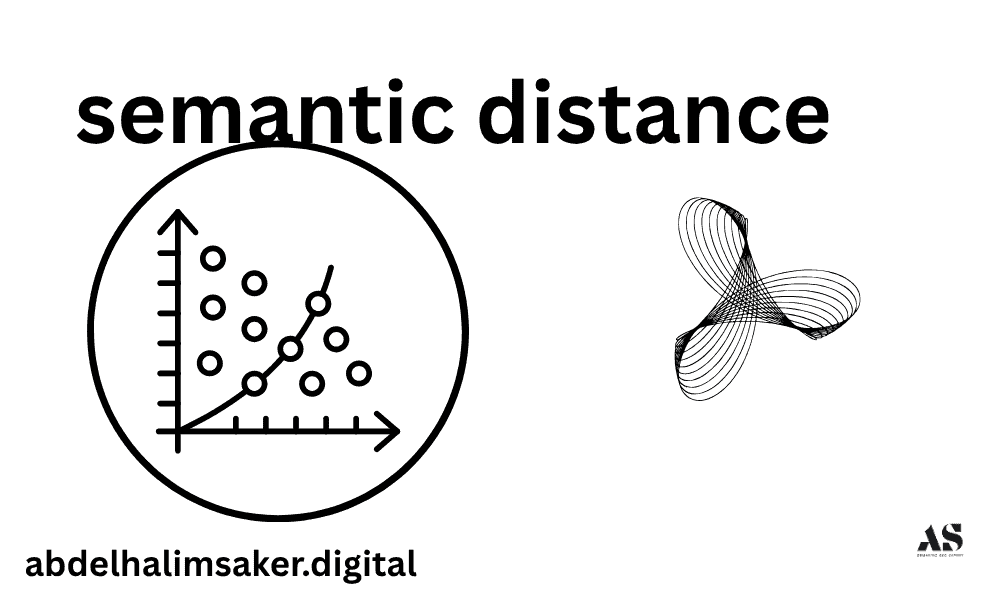
Semantic distance is the measure of conceptual similarity or difference between entities in a linguistic or knowledge graph.
Search engines like Google use semantic distance to determine how closely related two terms, concepts, or entities are within a given context.
In simple terms:
- A short semantic distance means two entities share a strong conceptual relationship.
- A long semantic distance means the entities belong to distant or unrelated conceptual domains.
Understanding and optimizing for semantic distance is critical in semantic SEO because it helps structure content around meaningful relationships, not just keyword proximity.
What Semantic Distance Represents
Semantic distance represents the contextual closeness or difference between words, entities, or topics within a semantic space.
In computational linguistics, it acts as a quantitative measure that expresses how similar two meaning vectors are.
The shorter the distance, the higher the similarity — meaning the entities are contextually aligned.
Core Concept
Search engines model language as multi-dimensional semantic spaces.
Each word, phrase, or entity is represented as a vector (a coordinate in that space).
The distance between vectors expresses how closely concepts relate.
Example:
- “Car” and “Vehicle” → Short semantic distance (conceptually close).
- “Car” and “Bicycle” → Moderate distance (related but different categories).
- “Car” and “Banana” → Long semantic distance (unrelated).
This framework enables Google to evaluate meaning even when exact keywords differ, improving query understanding and content relevance matching.
Semantic triple example:
- (Semantic distance) → (measures) → (conceptual similarity).
- (Short distance) → (indicates) → (close contextual relevance).
How Google Measures Semantic Distance
Google uses neural language models to calculate semantic distance through word embeddings, co-occurrence analysis, and vector representation.
Each method contributes to how the search engine interprets meaning and evaluates topical coherence across documents.
1. Word Embeddings
Word embeddings are mathematical representations that encode words into vectors based on their usage contexts.
Models like Word2Vec, BERT, and MUM capture the semantic relationships between words by learning from billions of sentences.
In these models, semantically similar words appear close together in vector space.
Example (Word2Vec concept):
If the model learns that “king” – “man” + “woman” ≈ “queen”,
it demonstrates that semantic relationships are not just about surface words but conceptual transformations.
Google applies this principle when matching queries to content — by comparing vector proximity, not just keyword overlap.
Semantic triple:
- (Google) → (represents) → (word meaning as vectors).
- (Vectors) → (enable) → (semantic distance calculation).
2. Co-Occurrence Frequency
Co-occurrence frequency measures how often entities appear together across documents or sentences.
High co-occurrence indicates strong topical association, which reduces semantic distance.
Example:
- “Solar energy” and “photovoltaic panels” frequently appear together → Short semantic distance.
- “Solar energy” and “restaurant recipes” rarely co-occur → Long semantic distance.
Google’s systems analyze co-occurrence patterns across large corpora to build entity graphs where related entities are linked by weighted connections.
These connections define the semantic geometry of the knowledge graph.
3. Vector Representation and Distance Metrics
Once entities and words are represented as vectors, Google uses distance metrics like cosine similarity to compute how close they are.
Cosine similarity measures the angle between two vectors:
- Cosine = 1 → Perfect semantic similarity.
- Cosine = 0 → No relation.
- Cosine = -1 → Opposite meaning.
Example:
- Similarity(“content marketing”, “SEO strategy”) = 0.86 (close).
- Similarity(“content marketing”, “coffee cup”) = 0.12 (far).
This vector-based understanding allows Google to:
- Detect synonyms and related phrases automatically.
- Cluster thematically coherent content.
- Rank pages based on semantic precision, not just term frequency.
4. Entity Co-Reference and Graph Proximity
In the Knowledge Graph, each entity (like Tesla, Elon Musk, Electric Vehicle) exists as a node.
Semantic distance in this graph depends on the number and strength of links between nodes.
Example:
- Tesla ↔ Elon Musk → 1-step distance (direct link).
- Tesla ↔ SpaceX → 2-step distance (through Elon Musk).
- Tesla ↔ Solar Energy → 3-step distance (through renewable technology).
These graph-based distances represent real-world conceptual proximity.
They help Google infer meaning when exact textual connections are missing.
Examples of Short vs Long Semantic Distance
| Comparison Pair | Semantic Distance | Reason |
|---|---|---|
| “SEO” – “Search Engine Optimization” | Short | Same concept, lexical variation |
| “SEO” – “Content Marketing” | Medium | Related topics, different focus |
| “SEO” – “Climate Change” | Long | Distinct domains |
| “Apple” – “iPhone” | Short | Brand-product relationship |
| “Apple” – “Banana” | Medium | Both fruits, same category |
| “Apple” – “Tesla” | Long | Unrelated industries |
Insight:
Semantic distance reflects how humans intuitively link ideas, but Google quantifies it mathematically.
This allows it to expand queries, understand synonyms, and group related search intents efficiently.
How Context Affects Semantic Weight
Context dynamically changes the semantic weight of words and entities.
The same term may shift meaning depending on its surrounding context — altering its distance from other entities.
Example:
- In a tech article: “Apple” → close to iPhone, iOS, MacBook.
- In a recipe article: “Apple” → close to fruit, pie, nutrition.
Google’s contextual embedding models (BERT, MUM) analyze sentence-level and paragraph-level context to update the semantic coordinates of entities dynamically.
This allows Google to avoid misclassification and maintain context-specific precision in rankings.
Practical SEO Applications of Semantic Distance
Understanding semantic distance allows SEOs and content creators to optimize text for meaning-based relationships, not just keywords.
It enhances topical authority, internal linking, and contextual alignment between clusters.
1. Optimizing Anchor Texts
Anchor text serves as a semantic bridge between linked pages.
The closer the anchor phrase’s meaning is to the target page’s entity, the shorter the semantic distance — strengthening topical relevance.
Example:
- Better anchor: “Technical SEO factors” → points to a technical SEO guide.
- Poor anchor: “Click here” → lacks semantic link, long distance.
Rule:
Maintain semantic consistency between anchor text, link target, and surrounding sentence context.
2. Structuring Headings Around Semantic Proximity
Headings define semantic clusters within your content.
Each H2 or H3 should represent a concept semantically close to the main entity of the page.
Example for an article on “Semantic SEO”:
- H2: “How Google Understands Entities” → close relation (short distance).
- H2: “Common Keyword Research Mistakes” → moderate relation (medium distance).
- H2: “Best Social Media Platforms for Ads” → weak relation (long distance).
Shorter semantic distances between headings signal to Google that the page maintains contextual cohesion, improving content quality scoring.
3. Surrounding Term Optimization
Google evaluates not just the target keyword, but also co-occurring terms around it.
By including semantically related phrases, you reduce the conceptual distance between entities and strengthen meaning density.
Example:
For “SEO content writing,” related surrounding terms include:
- search intent, topical relevance, content optimization, semantic keywords, entity linking.
Each of these phrases reinforces proximity to the main topic.
This strategy forms a semantically compact content vector, improving both NLP comprehension and rank stability.
4. Internal Linking with Semantic Proximity
Internal links with short semantic distances create strong contextual pathways within your website’s knowledge graph.
Search engines use these links to interpret your site-level semantic structure.
Example structure:
- What Is Query Semantics → links to → How Google Measures Semantic Distance.
- Contextual Hierarchy in SEO → links to → Passage Indexing Optimization.
Such connections help Google see your domain as a coherent topical ecosystem rather than a group of isolated pages.
5. Balancing Semantic Variety and Distance
Avoid clustering only closely related terms, as this can limit coverage depth.
Instead, structure clusters that balance short-distance and medium-distance entities to create semantic richness.
Example:
Main topic: Machine Learning in SEO
- Short distance: RankBrain, embeddings, vectorization.
- Medium distance: User behavior modeling, intent prediction, content scoring.
- Long distance (exclude): Graphic design trends.
Balanced variety creates a robust semantic field that reflects expertise and topical completeness.
Measuring Semantic Distance with NLP Tools
Modern NLP tools and APIs allow SEOs to quantify semantic distance between terms, entities, or topics.
This helps in content planning, semantic auditing, and topical clustering.
1. Word Embedding Models
Tools like Word2Vec, GloVe, FastText, and Google’s BERT embeddings provide vector representations of words.
You can use these to compute cosine similarity and visualize semantic relationships.
Example (Python-like pseudocode):
similarity("SEO", "Content Marketing") = 0.84
similarity("SEO", "Banana") = 0.06
These values quantify semantic closeness in the same way Google’s ranking algorithms interpret it.
2. Cosine Similarity Calculators
Online tools or NLP libraries compute the cosine similarity between two term embeddings.
They provide a numeric measure between 0 and 1 indicating semantic proximity.
| Pair | Cosine Similarity | Semantic Distance |
|---|---|---|
| SEO – On-page Optimization | 0.90 | Very Short |
| SEO – Brand Awareness | 0.55 | Moderate |
| SEO – Weather Forecast | 0.03 | Long |
This metric helps identify which keyword pairs or headings are semantically aligned, guiding both keyword clustering and internal linking.
3. Entity Graph Visualizers
Tools like InLinks, TextRazor, Google NLP API, and Diffbot can extract entities from your text and visualize them as knowledge graphs.
Each connection in the graph has a weighted edge, reflecting semantic distance.
Example:
- Entity graph for “SEO Content Optimization” might connect:
- SEO ↔ Google Search (0.93)
- SEO ↔ Readability (0.78)
- SEO ↔ Digital Advertising (0.52)
Shorter edges represent closer relationships.
Analyzing these graphs helps you refine content clusters, ensuring tight topical focus and minimizing semantic drift.
4. Topic Modeling and Co-Occurrence Matrices
Using Latent Semantic Analysis (LSA) or Latent Dirichlet Allocation (LDA), you can build topic models that reveal how frequently entities co-occur across documents.
Shorter semantic distances appear as denser clusters in the matrix.
This helps determine which topics belong in the same semantic cluster and which should be treated as separate content silos.
Why Semantic Distance Matters for SEO Strategy
- Improves Query Matching:
Pages optimized for semantically related terms rank for broader keyword variations. - Enhances Topical Authority:
Consistent short-distance clusters show Google you understand the domain holistically. - Guides Internal Linking Logic:
Semantic proximity helps structure links that reinforce conceptual relationships. - Reduces Keyword Cannibalization:
Understanding distances prevents overlapping pages targeting nearly identical intents. - Supports AI Content Validation:
NLP tools can verify whether your content stays within the expected semantic field of the topic.
Semantic triple summary:
- (Semantic distance) → (shapes) → (content structure).
- (Short distances) → (enhance) → (relevance and authority).
Integrating Semantic Distance into Topical Maps
When designing a topical map, consider semantic distance between nodes to ensure coherent clustering.
Example cluster for “Semantic SEO”:
| Node | Semantic Distance (to main topic) | Action |
|---|---|---|
| “Query Semantics” | 0.12 | Core cluster node |
| “Contextual Hierarchy” | 0.18 | Supporting node |
| “Entity Attributes” | 0.20 | Mid-cluster node |
| “Passage Indexing” | 0.24 | Outer cluster node |
Nodes with short distances form the core topical layer, while medium-distance nodes expand depth without breaking context.
This structure mirrors how Google’s knowledge graph layers concepts by semantic radius — from core entity outward.
Example of Semantic Cluster Design
Main Entity: Semantic SEO
Supporting Nodes (short distance): Query Semantics, Topical Authority, Entity Recognition
Extended Nodes (medium distance): Contextual Hierarchy, Passage Indexing, Semantic Distance
Peripheral Nodes (long distance): General UX Design, Website Speed
Mapping distances ensures your topical authority graph remains dense near the core and thinner at the periphery — mimicking Google’s conceptual hierarchy.
Final Insights
Search engines use semantic distance to measure the conceptual space between words, entities, and ideas.
By optimizing for semantic proximity, writers and SEOs help Google recognize the logical relationships embedded in their content.
Short semantic distances reinforce relevance, coherence, and authority — making each page a stronger node in the knowledge ecosystem.
Action summary for SEO:
- Use semantically related terms to shorten distance.
- Align headings and anchors with contextual proximity.
- Visualize entity relationships through knowledge graphs.
- Audit clusters regularly for semantic drift.
